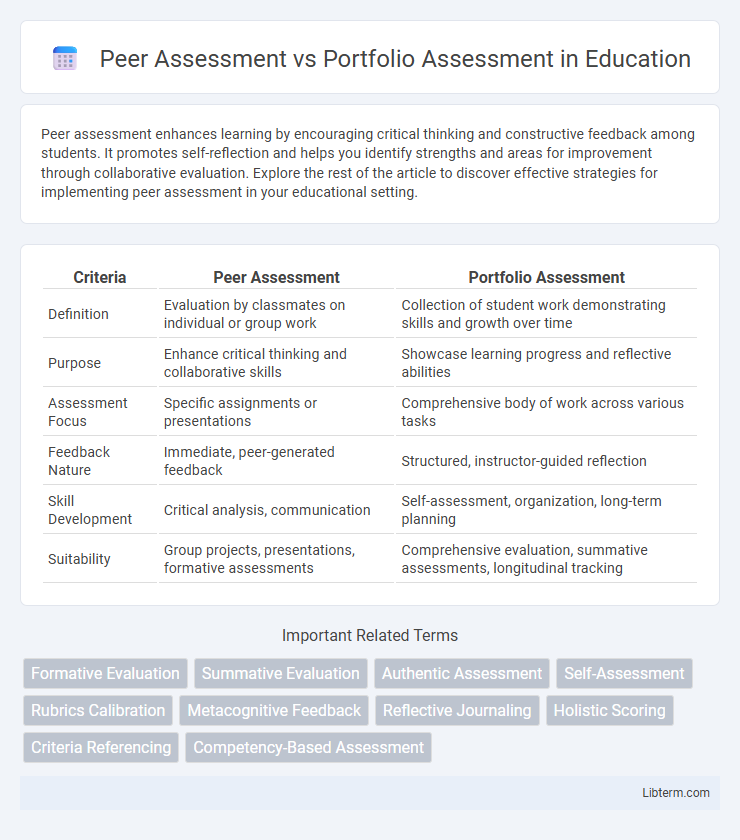Peer assessment enhances learning by encouraging critical thinking and constructive feedback among students. It promotes self-reflection and helps you identify strengths and areas for improvement through collaborative evaluation. Explore the rest of the article to discover effective strategies for implementing peer assessment in your educational setting.
Table of Comparison
| Criteria | Peer Assessment | Portfolio Assessment |
|---|---|---|
| Definition | Evaluation by classmates on individual or group work | Collection of student work demonstrating skills and growth over time |
| Purpose | Enhance critical thinking and collaborative skills | Showcase learning progress and reflective abilities |
| Assessment Focus | Specific assignments or presentations | Comprehensive body of work across various tasks |
| Feedback Nature | Immediate, peer-generated feedback | Structured, instructor-guided reflection |
| Skill Development | Critical analysis, communication | Self-assessment, organization, long-term planning |
| Suitability | Group projects, presentations, formative assessments | Comprehensive evaluation, summative assessments, longitudinal tracking |
Introduction to Assessment Methods
Peer assessment involves students evaluating each other's work, enhancing critical thinking and collaborative skills, while portfolio assessment compiles a student's work over time, showcasing growth and comprehensive understanding. Both methods emphasize formative feedback, but peer assessment fosters active engagement in the learning process, whereas portfolio assessment provides a holistic view of student progress. Effective introduction to these assessment methods highlights their complementary roles in diversified evaluation strategies.
Defining Peer Assessment
Peer assessment involves students evaluating each other's work based on established criteria, fostering critical thinking and collaborative learning. This method encourages active engagement, self-reflection, and the development of evaluative skills by allowing learners to provide constructive feedback. Unlike portfolio assessment, which compiles a student's work over time to demonstrate progress, peer assessment emphasizes interactive and formative evaluation among peers.
Understanding Portfolio Assessment
Portfolio assessment offers a comprehensive evaluation method by compiling a collection of a student's work over time, reflecting growth, skills, and achievements. This approach provides deeper insights into a learner's progress and critical thinking compared to peer assessment, which involves students evaluating each other's work and may focus more on immediate feedback. Portfolio assessment supports personalized learning by showcasing individual strengths and areas for improvement through diverse evidence and self-reflection.
Key Differences Between Peer and Portfolio Assessment
Peer assessment involves students evaluating each other's work, promoting collaborative learning and critical thinking skills, while portfolio assessment requires individuals to compile a collection of their work over time, highlighting personal growth and comprehensive skill development. Peer assessment emphasizes immediate feedback and diverse perspectives, whereas portfolio assessment focuses on self-reflection and long-term progress tracking. The key difference lies in peer assessment's interactive evaluation process compared to portfolio assessment's holistic, evidence-based documentation of achievement.
Advantages of Peer Assessment
Peer assessment enhances critical thinking by engaging students in evaluating their classmates' work, fostering deeper understanding and reflection. It promotes collaborative learning, improves communication skills, and provides diverse feedback that supports student growth. This method also increases learner autonomy and motivation by involving them actively in the assessment process.
Benefits of Portfolio Assessment
Portfolio assessment offers a comprehensive view of a student's progress by showcasing a variety of work samples over time, highlighting growth and depth of understanding. This method promotes reflective learning as students actively engage in selecting and evaluating their own work, fostering self-assessment skills. Unlike peer assessment, portfolio assessment provides a personalized and authentic representation of individual achievements and competencies.
Challenges and Limitations
Peer assessment faces challenges such as potential bias, varying levels of student expertise, and inconsistent grading standards, which can affect the reliability and fairness of evaluations. Portfolio assessment is limited by the time-intensive nature of compiling and reviewing comprehensive work samples, as well as difficulties in establishing standardized criteria for subjective content. Both methods require substantial instructor guidance to ensure validity and mitigate issues related to student motivation and academic integrity.
Impact on Student Learning Outcomes
Peer assessment enhances student learning outcomes by promoting critical thinking, self-reflection, and collaborative skills, leading to deeper understanding and retention of subject matter. Portfolio assessment impacts learning by encouraging continuous self-evaluation and documentation of progress over time, fostering personalized growth and mastery of competencies. Both methods improve learner engagement, but portfolios provide more comprehensive evidence of development across diverse skills and competencies.
Best Practices for Effective Implementation
Peer assessment effectiveness requires clear criteria, structured guidelines, and training to enhance objectivity and constructive feedback among students. Portfolio assessment best practices include regular student reflections, consistent evaluation rubrics, and integrating diverse evidence of learning to capture progress over time. Combining both methods promotes active learning, critical thinking, and comprehensive evaluation of student performance.
Choosing the Right Assessment Method
Choosing the right assessment method involves evaluating the purpose and desired outcomes of learning evaluation, where peer assessment fosters critical thinking and collaborative skills by engaging students in evaluating each other's work, while portfolio assessment provides a comprehensive view of student progress and skill development over time through collected works. Peer assessment is ideal for formative feedback and promoting active learning, whereas portfolio assessment suits summative evaluation and showcasing growth in complex skills. Balancing these methods depends on aligning assessment goals with the nature of the subject matter, student autonomy, and the need for both immediate feedback and longitudinal performance tracking.
Peer Assessment Infographic

 libterm.com
libterm.com